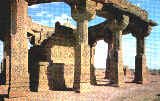|
|
Perhaps, you have never heard of people who thought like this strange ideas, but this was precisely how the people, who built Chowkundi Tombs, did. They built magnificent tombs and spent their life-long earnings on them, but hardly ever planned their living quarters with the same care and interest:
"There is no need of cities and towns either. Nothing, but graves. Graves to house their remains after death: Beautiful, ornate and lasting".
There is hardly any trace of their residential quarters today but, even after centuries, their tombs and graveyards continue to cast their solemn shadows across these vast stretches of wasteland.
Four miles around the site known as Chowkundi Tombs, there are no traces or remains of any ancient human settlement or habitation. Eighteen miles from Karachi, on Karachi-Thatta Highway, this grave yard had already been there for ages, when Karachi was non-existent.
Similar in the case of other such cities, of which there are no more than 20 in Sind and Baluchistan. Normally, graveyards are adjunct to cities or towns, but here the case is different. That is the whole essence of the mystery of Chowkundi site and others of this kind.
In inviting attention to this treasure of art, one need not march into the corridors of history or fly into the labyrinths of legends. It stands on its own merits. The site presents beauty of design, patter and craftsmanship of days gone by, so perfectly well-preserved even after hundreds of years.
Thousands of charcoal and crayon rubbings of the motifs of these tombs have been flown to Europe and America by great number of foreign visitors as gifts. This testifies to the appeal the excellence of designs make on the minds of Western connoisseurs.
In fact, Chowkundi is one of the most beautiful ancient sites in Pakistan. Craftsmen, who built tombs and carved and engraved them were remarkable for their sense of beauty and their devotion to their rich, inherited art. Not one, two or three, but hundreds of tombs, built of angular stone slabs placed one upon another and tapering upwards, like the tombs of Cyrus in Iranian Valley or Murghan, can be seen here at Chowkundi.
These tombs appeal to the aesthetic sense of the visitor from the monument he sees these golden sandstone slabs, beautified by art and craftsmanship. And for curious mind, they offer lot of material to observe and reflect upon. The encrusted superficial layers could be scratched to perhaps establish some very interesting facts. The obvious impression, which one gets is that no poor people could have afforded such splendors.
There a myriad types of floral patterns and geometrical designs, carved out in the huge slabs of stone with such supreme craftsmanship and precision as if done on silk. The best specimens of line and form, tombs present at intricate network of various patterns, incorporating triangles, rectangles, squares and circles, forming well-balanced and charming symmetrical designs. Patterns, resembling lotuses and sunflowers, profusely adorn the designs. Some of the tombs, also, have verses from Koran.
Prominent crown-like figures on the tomb immediately distinguish tombs of men from those of women, which are flat-topped. Their patterns also differ. Sword and shield, bow and arrow, flying horse rider and similar item symbolizing courage and bravery adorn men's tombs; but women's tombs have patterns and designs of delicate and beautiful ornaments, such as necklaces, earrings, rings "kangans" and "jhumkas" etc.
Inviting and enchanting, Chowkundi whispers mysteries of past and seems ever ready to disclose its secrets to the discerning, imaginative mind. For the lovers of art and crafts, as well as antiquarians and archaeologists, tombs are of special interest. Here, poet's mind conjures up the lives of those master craftsmen, who have left the mark of their skill on these tombs, as well as those who lie buried beneath them.

|
|

